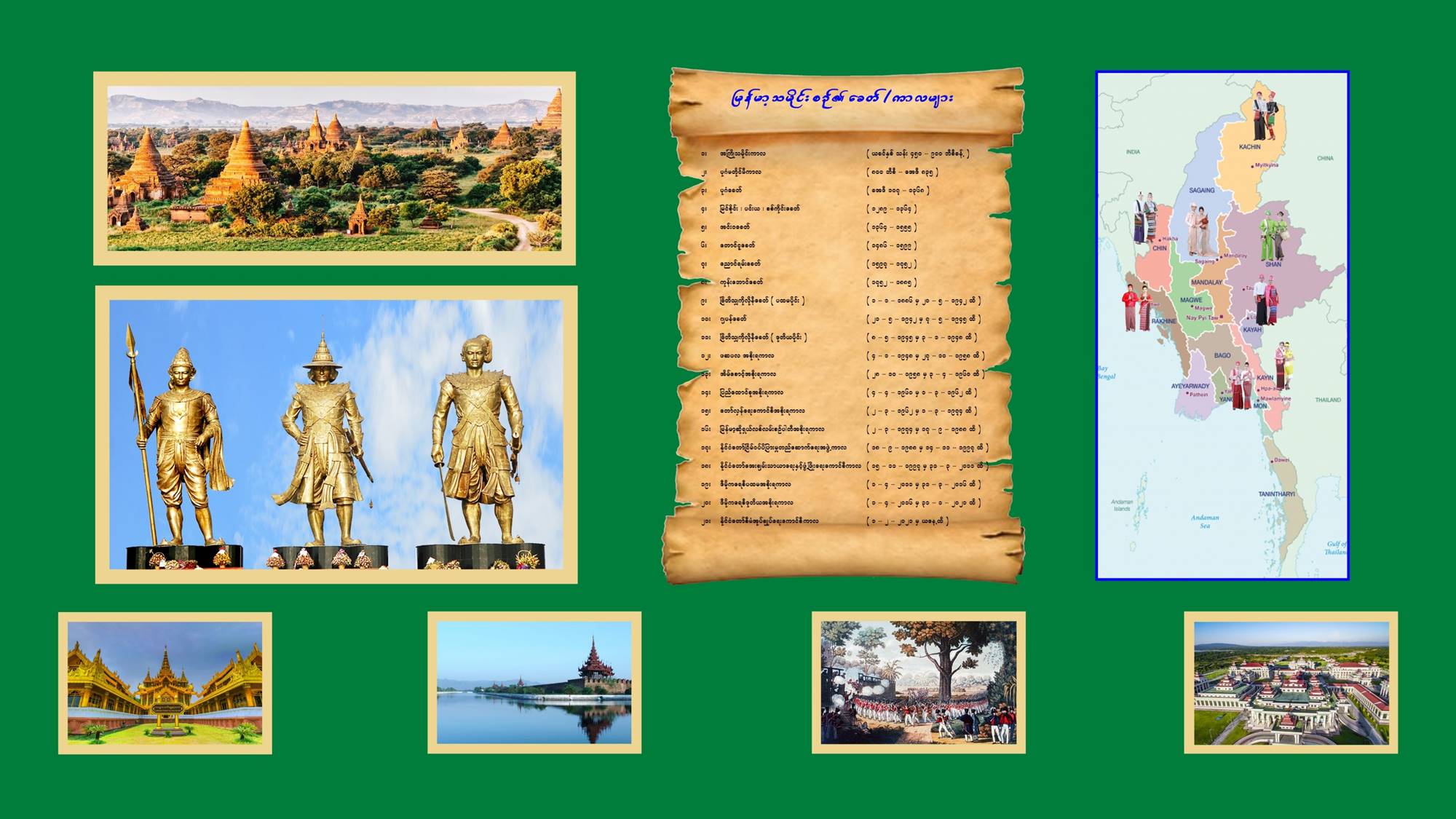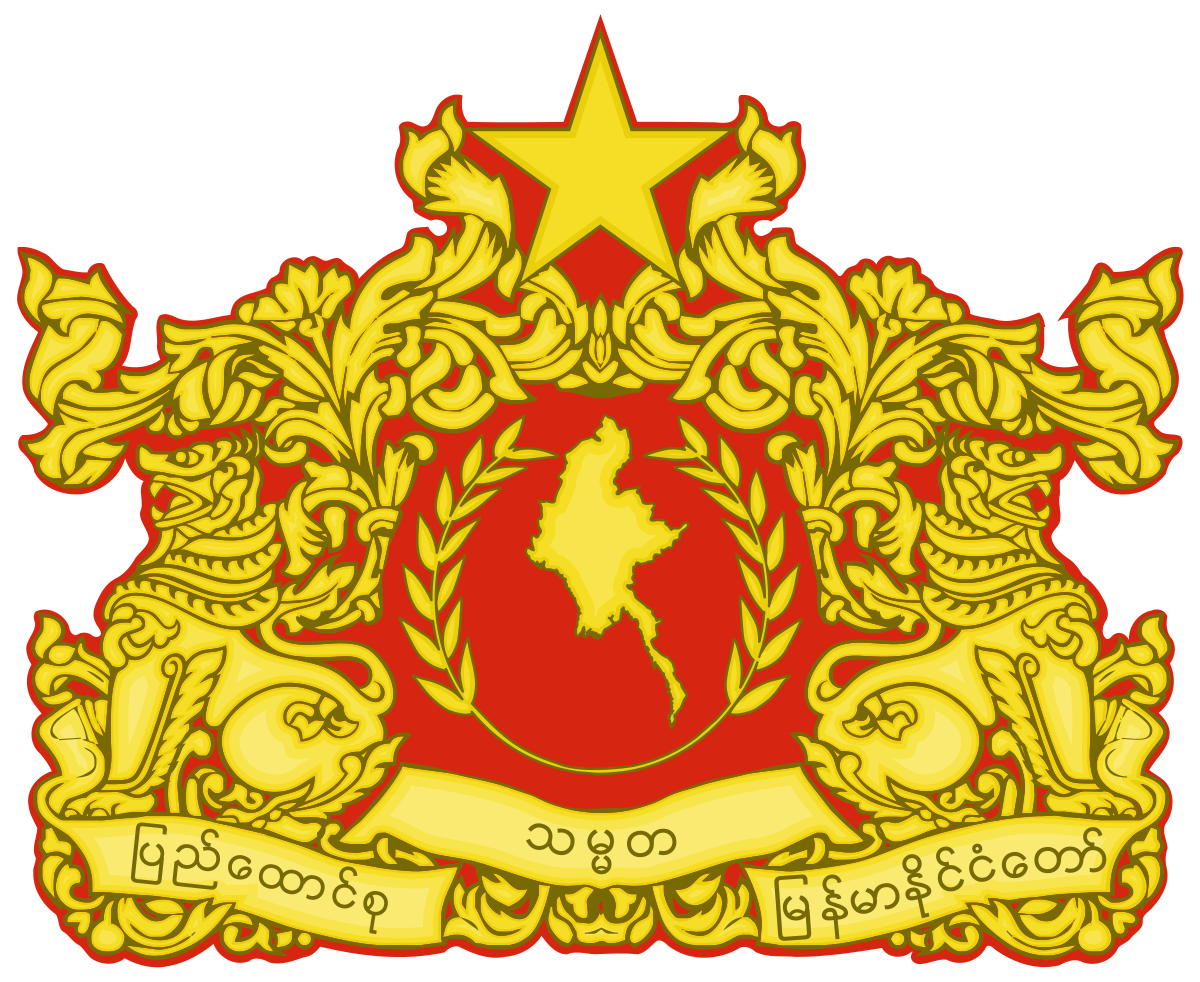နောက်ခံသမိုင်း

မြန်မာနိုင်ငံသမိုင်းကြောင်းအကျဉ်း
မကွေးတိုင်း၊ မြိုင်မြို့နယ်တွင် တွေ့ရှိရသော ပရိုင်းမိတ်များ၏ မေးရိုးအပိုင်းအစများအရ မြန်မာနိုင်ငံ၏ သမိုင်းကြောင်းသည် လွန်ခဲ့သော နှစ်သန်းပေါင်း ၄ဝ က စတင်ခဲ့သည်ဟု ဆိုရမည်ဖြစ်သည်။ ထို့အတူ ပုံတောင်နယ်တွင် တွေ့ရသဖြင့် ပုံတောင်ဂျီးယား(Pondaungia)ဟု အမည်ပေးထားသော တွေ့ရှိချက်နှင့် မိုးကောင်းရွာအနီးတွင် တွေ့ရှိသဖြင့် မိုးကောင်းဂျင်စစ် (Mogaungensis) ဟု အမည်ပေးထားသော တွေ့ရှိချက်များအရ မြန်မာနိုင်ငံတွင် လွန်ခဲ့သော နှစ်သန်းပေါင်း ၄ဝကာလ ကပင် လူသားမျိုးနွယ်စုများ နေထိုင်နေပြီဟု သတ်မှတ်ရမည် ဖြစ်ပေသည်။ မြန်မာနိုင်ငံ၊ ပုံတောင်ဒေသတွင် တွေ့ရှိခဲ့သော အဆင့်မြင့် ပရိုင်းမိတ်သည် ယခင်နှစ်သန်း ၄၀ သက်တမ်းရှိပြီး၊ အရုဏ်ဦး လူဝံ (Dawn Ape) ဟုခေါ်၍ Amphipithecus ဟုအမည်ပေးထားခဲ့သည်။
ထို့အတူ မြန်မာနိုင်ငံသည် ကမ္ဘာပေါ်ရှိ အခြားသော နိုင်ငံများကဲ့သို့ပင် ကျောက်ခေတ် ကာလကို ဖြတ်ကျော်ခဲ့သည်။ ကျောက်ခေတ်ဟောင်းလူသားများသည် မြန်မာနိုင်ငံ အလယ်ပိုင်း ဧရာဝတီမြစ်ရိုး တစ်လျှောက်တွင် အလယ်ပလိုင်စတိုဆင်းခေတ် (Middle Pleistocene) ကတည်းက စတင်နေထိုင်ခဲ့ကြသည်။ ၉၀၀၀ ဘီစီ (ယခင်နှစ် ၁၁၀၀၀) တွင် ကျောက်ခေတ် ဟောင်း နှောင်းပိုင်းကာလနှင့် ကျောက်ခေတ်သစ်ဦးပိုင်းကာလ ယဉ်ကျေးမှုသည် ပြဒါးလင်းဂူ တွင် ထွန်းကားခဲ့သည်။ ကျောက်ခေတ်သစ်လူသားများသည် ၅၇၄၀ ဘီစီ (ယခင်နှစ် ၇၇၄၀) မှ ၄၅၇၀ ဘီစီ(ယခင်နှစ် ၆၅၇၀)အထိ ပြဒါးလင်းဂူ တွင် နေထိုင်ခဲ့ကြသည်။ ကျောက်ခေတ်သစ် လက်နက်များကို တောင်ဘက် တနင်္သာရီမှ မြောက်ဘက် ပူတာအိုအထိ ၊ အနောက်ဘက် ရခိုင်ရိုးမတောင်ခြေမှ အရှေ့ဘက် သံလွင်မြစ်အထိ ကျယ်ပြန့်စွာ တွေ့ရှိခဲ့ရသည်။
ရှေဟောင်းသုတေသနနှင့်အမျိုးသားပြတိုက်ဦးစီးဌာန၏ တူးဖော်သုတေသနပြုချက်များ အရ ၉၀၀ ဘီစီခန့်တွင် ကြေးခေတ်နှောင်းပိုင်းကာလ လူ့အဖွဲ့အစည်းသည် ဘုတလင်မြို့နယ်၊ ညောင်ကန်ဒေသတွင်လည်းကောင်း ၊ ၇၁၀ ဘီစီခန့်တွင် သံခေတ်ဦးကာလ လူ့အဖွဲ့အစည်း တစ်ရပ်သည် တောင်သမန်ဒေသတွင်လည်းကောင်း ၅၃၀ ဘီစီမှ ၉၀ ဘီစီအတွင်း သံခေတ် လူ့အဖွဲ့အစည်းတစ်ရပ်သည် မန္တလေးတိုင်း၊ ရမည်းသင်းခရိုင် ၊ ပျော်ဘွယ်မြို့နယ်၊ ရွာထင်ကုန်းရွာတွင် လည်းကောင်း ပေါ်ထွန်းခဲ့ကြောင်း ဖော်ထုတ်နိုင်ခဲ့သဖြင့် မြန်မာနိုင်ငံတွင် ကျောက်ခေတ်၊ ကြေးခေတ်၊ သံခေတ် ယဉ်ကျေးမှုများ တစ်ဆက်တစ်စပ်တည်း ဖြစ်ပေါ်တည်ရှိ ခဲ့ကြောင်း မှတ်တမ်းတင်နိုင်ခဲ့ပြီဖြစ်သည်။
ယင်းနောက် ၁၀၀ ဘီစီမှ အေဒီ ၉ရာစုအတွင်း ပျူခေတ်တစ်ခေတ်တည်ရှိခဲ့ပြီး မြို့ပြများစတင် တည်ထောင်နိုင်ခဲ့ကြသည်။ ပျူတို့၏ ဗဟိုဌာနများမှာ ဟန်လင်း၊ သရေခေတ္တရာနှင့် ဗိဿနိုးမြို့ဟောင်းများဖြစ်ကြသည်။ ပျူတို့အနေဖြင့် ကျောက်ချပ်များ၊ ရွှေပေများ၊ အရိုးအိုးများ၊ အုတ်ခွက်များစသည့် ဝတ္ထုပစ္စည်းများပေါ်တွင် ကိုယ်ပိုင်စာပေဖြင့် မှတ်တမ်းတင်ရေးထိုးနိုင်ခဲ့ပေသည်။ ပျူလူမျိုးများသည် မြို့ပြများ ထူထောင်လျက် ကိုယ်ပိုင်အုပ်ချုပ်ရေး၊ ကိုယ်ပိုင်ယဉ်ကျေးမှုဖြင့် ကြီးကျယ်ခမ်းနားစွာနေထိုင် နိုင်ခဲ့ကြသည်။
အေဒီ ၁၀၇ ခုနှစ်တွင် သမုဒ္ဒရာဇ်မင်းသည် ပုဂံ ၁၉ ရွာကို အခြေပြု၍ ဧရာဝတီမြစ်မှ ၇ မိုင် အကွာ ယုန်လွှတ်ကျွန်းအရပ်၌ မင်းပြုခဲ့သည်။ ပျူစောထီးမင်းလက်ထက် အေဒီ ၁၆၇ ခုနှစ်တွင် အရိမဒ္ဒနာ ဟုခေါ်တွင်စေခဲ့သည်။ အေဒီ ၃၄၄ ခုနှစ်တွင် နန်းတက်သော သေဉ်လည်ကြောင်မင်း လက်ထက်တွင် အဆိုပါရွာ ၁၉ ရွာကို ဖျက်၍ လောကနန္ဒာအရပ်၌မြို့တည်ပြီး သီရိပစ္စယာဟူ၍ သမုတ်ခဲ့သည်။ အေဒီ ၅၁၆ ခုနှစ်တွင် နန်းတက်သော သိုက်တိုင်မင်းလက်ထက်တွင် သီရိ ပစ္စယာမှ ရွာစိုက်သို့ ပြောင်းရွှေ့မြို့တည်ခဲ့ပြီး တမ္ပဝတီဟူ၍ သမုတ်ခဲ့သည်။ ရှေးဟောင်းခေတ် မြန်မာနိုင်ငံတွင် ပေါ်ထွန်းခဲ့သောမြို့ပြနိုင်ငံများသည် ၉ ရာစုပတ်ဝန်းကျင်တွင်ဖရိုဖရဲဖြစ်လျက် အခြေအနေယိမ်းယိုင်နေခဲ့ရသည်။ ဤအခြေအနေမှာပင် နောက်ထပ်နိုင်ငံသစ်တစ်ခု ထူထောင် နိုင်ရေး ခေတ်ဟောင်းနိုင်ငံသားများက ကြိုးပမ်းခဲ့ရာမှ အေဒီ၈၄၉ ခုနှစ်တွင် ပျဉ်ပြားမင်းက ပုဂံမြို့ကို စတင်တည်ထောင်ခဲ့သည်။
ပုဂံမင်းဆက် ၅၅ ဆက်အနက် ၄၂ ဆက်မြောက်ဖြစ်သော အနော်ရထာမင်း (အေဒီ ၁၀၄၄-၁၀၇၇ ) လက်ထက်တွင် စစ်ရေး၊ စီးပွားရေး၊ လူမှုရေး၊ နည်းလမ်းအမျိုးမျိုးကို အသုံးပြုပြီး ပထမမြန်မာနိုင်ငံတော်ကြီးကို ထူထောင်ခဲ့ရာမှ ကမ္ဘာ့မြေပုံတွင် မြန်မာနိုင်ငံဟု ကမ္ပည်းမော်ကွန်း တင်နိုင်ခဲ့ပြီး ပုဂံခေတ်ကို ထူထောင်နိုင်ခဲ့သည်။ နရသီဟပတေ့မင်း (အေဒီ ၁၂၅၆ - ၁၂၈၇ ) လက်ထက်စီးပွားရေးအရ အကြပ်အတည်း ဖြစ်လာသည့်အတွက် နိုင်ငံရေးအခြေအနေမှာလည်း မခိုင်မမြဲဖြစ်လာခဲ့ရသည်။ ဧကရာဇ်၏ ဩဇာအာဏာမခိုင်မြဲသဖြင့် လက်အောက်မှတော်လှန် ပုန်ကန်မှုများဖြစ်လာခဲ့ရသည်။ ၁၂၇၇ ခုနှစ်တွင် မွန်ဂိုတပ်များနှင့် ပုဂံတပ်များ စတင်တိုက်ခိုက် ခြင်းဖြင့် မွန်ဂိုကျူးကျော်စစ် စတင်ခဲ့ရသည်။ ဒလစားကျော်စွာ (၁၂၈၇ -၁၂၉၈ ) ပုဂံထီးနန်းကို ဆက်ခံချိန်တွင် ကျောက်ဆည်လယ်တွင်း ၁၁ ခရိုင်တွင် စီးပွားရေးနှင့် အုပ်ချုပ်ရေးအင်အား ကြီးမားလာသော ရှမ်း-မြန်မာ မင်းညီနောင် သုံးဦးနှင့် ရင်ဆိုင်လာခဲ့ရတော့သည်။ ၁၃၂၅ ခုနှစ်တွင် စောနှစ်၏ သားတော် စောမွန်နစ် ပုဂံထီးနန်းဆက်ခံချိန်မှစ၍ ပုဂံနိုင်ငံတော်၏ အုပ်ချုပ်ရေးမှာ ပြယုဂ်မျှသာဖြစ်ခဲ့ပြီး ၁၃၆၈ ခုနှစ်တွင် ပြိုကွဲခြင်းသို့ ရောက်ရှိခဲ့ရသည်။
ရှမ်း-မြန်မာ မင်းညီနောင်သုံးဦးဖြစ်သော အသင်္ခယာ၊ ရာဇသင်္ကြံ ၊ သီဟသူတို့အနက် အငယ်ဆုံးဖြစ်သော သီဟသူသည် ၁၃၁၂ ခုနှစ်တွင် ပင်းယမြို့ကို တည်ထောင်၍ ဝိဇယပူရဟုခေါ်တွင်စေခဲ့ပြီး မင်းနေပြည်တော်အဖြစ် ပြုလုပ်ခဲ့သည်။ သီဟသူတွင် ဉဇနာ၊ကျော်စွာ၊ နော်ရထာ၊ အသင်္ခယာစောယွမ်းနှင့် တရဖျားကြီးစသည့် ထက်မြက်သော သားတော်များရှိခဲ့သည်။ သားတော်တစ်ပါးဖြစ်သူ အသင်္ခယာစောယွမ်းသည် စစ်ကိုင်းကိုဗဟိုပြု၍ မြောက်ဘက်ဒေသများကို စုစည်းတည်ထောင်ရာမှ စစ်ကိုင်းသည် ပဒေသရာဇ်နိုင်ငံအသစ်အဖြစ် ၁၃၁၅ ခုနှစ်မှစ၍ ထင်ရှားလာခဲ့သည်။ သို့သော် ၁၃၆၄ ခုနှစ်တွင် ရှမ်းပဒေသရာဇ် သိုချည်ဘွားခေါင်းဆောင်သော တပ်များသည် တကောင်း၊ ပင်းယနှင့်စစ်ကိုင်းတို့အား အပြင်း အထန်လာရောက်တိုက်ခိုက်ခဲ့ရာ ထိုနှစ်အတွင်း ပထမဆုံးအနေဖြင့် စစ်ကိုင်း ဆက်လက်၍ ပင်းယစသည့် နိုင်ငံငယ်များ အသီးသီး ပျက်သုဉ်းခဲ့ရသည်။
ပင်းယနှင့်စစ်ကိုင်းပျက်၍ နိုင်ငံကို ပြန်လည်စည်းရုံး ထူထောင်ခဲ့သူမှာ စစ်ကိုင်း၊ အသင်္ခယာ စောယွမ်း၏ မျိုးရိုး တကောင်းစား သတိုးမင်းဖျားဖြစ်သည်။ သတိုးမင်းဖျားသည် ၁၃၆၄ ခုနှစ်တွင် ကျည်အင်း၊ ကျောက်မော်အင်း၊ အင်းတူးအင်း၊ ဥန္နဲအင်းတို့ကို ဖို့၍
၎င်းအင်းတို့၏ အဝတွင် မြို့တည်ခဲ့သည့်အတွက် အင်းဝဟူ၍ လည်းကောင်း၊ အဝဟူ၍ လည်းကောင်း ခေါ်တွင်စေခဲ့သည်။ အဝကိုတည်ထောင်ခဲ့ပြီးနောက် သတိုးမင်းဖျားသည် နိုင်ငံအဝန်းကိုလှည့်လှှည်တိုက်ခိုက်သိမ်းသွင်းခဲ့ရာမှ သတိုးမင်းဖျားနှင့် ထိုမင်းကို ဆက်ခံသော မင်းများ၏ ကြိုးပမ်းမှုကြောင့် အင်းဝခေတ် (၁၃၆၄-၁၅၅၅) ကိုထူထောင်နိုင်ခဲ့ကြသည်။ အင်းဝဖွံ့ဖြိုးတိုးတက်ချိန်တွင် တစ်ဖက်တွင်လည်း ပဲခူး (ဟံသာဝတီ)သည်လည်း ပေါ်ထွန်း လာခဲ့သည်။ မကြာမီကာလတွင် မြန်မာပြည်တောင်ဘက်ပိုင်းရှှိပဲခူး (ဟံသာဝတီ) ပဒေသရာဇ် တို့နှင့် အင်အားချင်းယှဉ်ပြိုင်သော ကြာညောင်းလှသည့် အင်းဝ - ဟံသာဝတီအနှစ် ၄၀ စစ်ပွဲကြီးအား ပြည်သူပြည်သားတို့ ကြုံတွေ့လာခဲ့ကြရသည်။
ဒုတိယမင်းခေါင်၏ သားတော်ရွှေနန်းကြော့ရှင်နရပတိ(၁၅၀၁-၁၅၂၇) လက်ထက်တွင် မူ အဝ၏ အခြေအနေမှာများစွာ ယိမ်းယိုင်နေခဲ့ပြီဖြစ်သည်။ တောင်ငူအင်အားတောင့်တင်းလာ သဖြင့် ရွှေနန်းကြော့ရှင်သည် ရေလွှဲငါးခရိုင်ကို တောင်ငူသို့ ပေးခဲ့ရသည်။ ဤကဲ့သို့ အခြေအနေများ ယိမ်းယိုင်ပျက်ပြားနေစဉ် (၁၅၂၆-၁၅၂၇)အတွင်း အဝကို မိုးညှင်းစလုံနှင့် သားသိုဟန်ဘွားတို့ ချီတက်၍ တိုက်ခိုက်ရာ ရွှေနန်းကြော့ရှင်ကျဆုံးခဲ့ပြီး အဝထီးနန်းကို သိုဟန်ဘွား (၁၅၂၇-၁၅၄၂) ကသိမ်းယူအုပ်စိုးခဲ့သည်။ တောင်ငူ၌ ၁၅၃၀ ပြည့်နှစ်တွင် မင်းကြီးညိုအနိစ္စရောက်၍ သားတော်တပင်ရွှေထီးနန်းတက်လာခဲ့ပြီးနောက် တပင်ရွှေထီးသည် ညီညွတ်သော နိုင်ငံတော်တစ်ရပ်တည်ဆောက်ရန် အင်အားစုဆောင်းခဲ့သည်။ ထိုမှဘုရင့်နောင် လက်ထက်တွင် ဟံသာဝတီလက်အောက်သို့ လုံးဝကျရောက်ခဲ့ရပြီး အင်းဝပဒေသရာဇ်နိုင်ငံ ပျက်သုဉ်းခဲ့ရသည်။
ဘုရင့်နောင်သည် တစ်တိုင်းပြည်လုံးကို ဩဇာဖြန့်လျက်သိမ်းသွင်းစည်းရုံးခဲ့ရာ အေဒီ ၁၆ရာစုနှစ်ဦး၌ မြန်မာနိုင်ငံတွင် ပြိုင်ဘက်ကင်းသော ဧကရာဇ်ဖြစ်လာခဲ့ပြီး ဒုတိယ မြန်မာနိုင်ငံတော်ကြီးကို ထူထောင်နိုင်ခဲ့သည်၊၊ တစ်နိုင်ငံလုံးကို သိမ်းပိုက်ရရှိပြီးနောက် မြန်မာပြည်အရှေ့ဘက်၊ အနောက်ဘက် မြောက်ဘက်နှင့် အရှေ့တောင်ဒေသများကိုလည်း မိမိ၏ လက်နက်နိုင်ငံအဖြစ် သိမ်းသွင်းခဲ့ရာမှ ရာမညတိုင်း ဟံသာဝတီပြည်ဖြစ်လာခဲ့သည်။ သို့သော် ဘုရင့်နောင်၏ လက်အောက်ခံနယ်ပယ်တိုင်းနိုင်ငံတို့မှ အစဉ်အမြဲငြိမ်ဝပ်နေကြသည်မဟုတ်ဘဲ အခွင့်သာလျှင် သာသလိုခြားနားပုန်ကန်မှုများ ပြုနေသည့်အတွက် ဘုရင့်နောင်၏ အုပ်ချုပ်ရေး သက်တမ်းတစ်လျှောက် နှိမ်နှင်းရေး စစ်ပွဲများကို မပြတ်မလပ်ဆင်နွှဲနေရခြင်းဖြင့်သာ အချိန်ကုန်လွန်ခဲ့ရသည်။ နန္ဒဘုရင်လက်ထက် ၁၅၉၉ခုနှစ်တွင် တောင်ငူမင်း၊ ရခိုင်မင်းတို့ ပူးပေါင်း၍ ဟံသာဝတီကို လုပ်ကြံခဲ့ရာ ဟံသာဝတီနေပြည်တော် ယိုယွင်းပျက်သုဉ်းခဲ့ရသည်။
ဟံသာဝတီနေပြည်တော် ပျက်ယွင်းချိန်တွင် ဘုရင့်နောင်၏ သားတော်ညောင်ရမ်းမြို့စား မင်းရဲ နန္ဒမိတ်သည် လေးနှစ်တိုင်တိုင်လူသူကင်း၍ ယိုယွင်းပျက်စီးလျက်ရှိသော အဝမြို့ကို မြို့သစ်တည်ထောင်၍ အထက်တစ်လွှားကို စုစည်းသိမ်းသွင်းခဲ့ရာမှ ညောင်ရမ်းခေတ် (အေဒီ ၁၆၀၀- ၁၇၅၂ ) ကို စတင်ထူထောင်ခဲ့ပြန်သည်။ ၁၇၃၃ ခုနှစ် မဟာ ဓမ္မရာဇာဓိပတိ အဝထီးနန်းရသည်နှင့် နန်းတွင်း၊ ပြည်တွင်းနှင့် ပြည်ပအန္တရာယ်များ စုပြုံကျရောက်လာသည်။ အဝ၏ အခြေအနေမှာ တောင်ဘက်တွင် ဟံသာဝတီသားတို့၏ ပုန်ကန်မှု ၊ အဝအနီးမတ္တရာ၊ အုတ်ဖိုဘက်တွင် ကုဏ္ဏအိန် ဦးဆောင်သော ပုန်ကန်မှုနှင့် အနောက်ဘက်နယ်စပ်ကို မကြာခဏ ထိပါးလေ့ရှိသော မဏိပူရ (ကသည်း)တို့၏ ထိပါးနှောင့်ယှက်မှုများကြုံတွေ့ လာခဲ့ရသည်။ ၁၇၅၁ခုနှစ်တွင် ဟံသာဝတီဗညားဒလ (ဦးအောင်လှ)၏ ညီတော်ဥပရာဇာ၏ တပ်များသည် အဝကိုဦးတည်၍ ကြည်းကြောင်း၊ ရေကြောင်းဖြင့် ချီတက်တိုက်ခိုက်ခဲ့ရာ ၁၇၅၂ခုနှစ် ဧပြီလတွင် ဟံသာဝတီမင်း၏ ညီတော် ဥပရာဇာ၏ တပ်များ လက်တွင်းသို့ ကျရောက်ခဲ့ကာ အဝဧကရာဇ် နိုင်ငံတော်ပျက်သုဉ်းခဲ့ရတော့သည်။
ဤအခြေအနေတွင် အလောင်းမင်းတရားကြီးသည် ပြိုကွဲလျက်ရှိသော တစ်နိုင်ငံလုံးအား ပြန်လည်စုစည်း၍ တတိယမြန်မာနိုင်ငံတော်၊ ကုန်းဘောင်ခေတ် (အေဒီ ၁၇၅၂ - ၁၈၈၅ )အား ထူထောင်နိုင်ခဲ့သည်။ ကုန်းဘောင်ခေတ်အတွင်း အင်္ဂလိပ်တို့နှင့် ၁၈၂၄-၁၈၂၆ ခုနှစ်တွင် ပထမစစ်ပွဲ၊ ၁၈၅၂ ခုနှစ်တွင် ဒုတိယစစ်ပွဲ၊ ၁၈၈၅ခုနှစ်တွင် တတိယစစ်ပွဲများ ဖြစ်ပွားခဲ့ပြီး မြန်မာတစ်နိုင်ငံလုံး အင်္ဂလိပ်ကိုလိုနီဘဝသို့ ကျရောက်ခဲ့ရာမှ ၁.၁.၁၈၈၆ မှ ၂၀.၅.၁၉၄၂ အထိ ဗြိတိသျှကိုလိုနီခေတ် (ပထမ)ပိုင်းကို ကြုံတွေ့ခဲ့ရပြန်သည်။ ထိုမှ ဗိုလ်ချုပ်အောင်ဆန်း ဦးဆောင်သော ဗမာ့လွတ်လပ်ရေးတပ်မတော်သည် ဂျပန်တို့၏ အကူအညီဖြင့် မြန်မာတစ်နိုင်ငံ လုံးအား ပြန်လည်သိမ်းပိုက်ခဲ့ရာမှ အစပြု၍ ၂၁.၅.၁၉၄၂ မှ ၇.၅.၁၉၅၄ အထိ ဂျပန်ခေတ်ကို လည်းကောင်း၊ ဖက်ဆစ်ဂျပန်တို့အား ပြန်လည်တော်လှန်တိုက်ခဲ့ရာမှ ၈.၅.၁၉၄၅ မှ ၃.၁.၁၉၄၈ အထိ ဗြတိလျှကိုလိုနီခေတ် (ဒုတိယပိုင်း)ကို လည်းကောင်း ထပ်မံကျော်ဖြတ်ခဲ့ရပြန်သည်။ ထိုမှ ဗိုလ်ချုပ်အောင်ဆန်းနှင့် အမျိုးသားခေါင်းဆောင်ကြီးများ၏ ကြိုးပမ်းအားထုတ်မှုကြောင့် ၁၉၄၈ ခုနှစ်၊ ဇန်နဝါရီလ ၄ ရက်တွင် လွတ်လပ်ရေးရရှိခဲ့ပြီး အချုပ်အခြာအာဏာပိုင် နိုင်ငံတစ်ခုအဖြစ်သို့ ပြန်လည်ရောက်ရှိခဲ့ရသည်။
လွတ်လပ်ရေးရရှိပြီးနောက် မြန်မာနိုင်ငံသည် ဖဆပလအစိုးရကာလ (၄.၁.၁၉၄၈ မှ ၂၇.၁၀.၁၉၅၈ ထိ) ၊ အိမ်စောင့်အစိုးရကာလ (၂၈.၁၀.၁၉၅၈ မှ ၃.၄.၁၉၆၀ထိ) ၊ ပြည်ထောင်စု အစိုးရကာလ (၄.၄.၁၉၆၀ မှ ၁.၃.၁၉၆၂ ထိ) တော်လှန်ရေးကောင်စီအစိုးရကာလ (၂.၃.၁၉၆၂ မှ ၁.၃.၁၉၇၄ ထိ) ၊ မြန်မာ့ ဆိုရှယ်လစ်လမ်းစဉ်ပါတီကာလ (၂.၃.၁၉၇၄ မှ ၁၇.၉.၁၉၈၈ထိ) ၊ နိုင်ငံတော် ငြိမ်ဝပ်ပိပြားမှု တည်ဆောက်ရေးအဖွဲ့ ကာလ (၁၈.၉.၁၉၈၈ မှ ၁၄.၁၁.၁၉၉၇ ထိ) ၊ နိုင်ငံတော်အေးချမ်းသာယာရေးနှင့် ဖွံ့ဖြိုးရေးကောင်စီကာလ (၁၅.၁၁.၁၉၉၇ မှ ၃၁.၃.၂၀၁၁ထိ) ဒီမိုကရေစီပထမ အစိုးရကာလ (၁.၄.၂၀၁၁ မှ ၃၁.၃.၂၀၁၆ ထိ)၊ ဒီမိုကရေစီ ဒုတိယအစိုးရကာလ (၁.၄.၂၀၁၆ မှ ၃၁.၁.၂၀၂၁ ထိ) စသည့် ကာလအသီးသီကို ဖြတ်သန်းခဲ့ပြီး ယခုအခါ နိုင်ငံတော် စီမံအုပ်ချုပ်ရေးကောင်စီ (၁.၂.၂၀၂၁ မှ ယနေ့ထိ) ၏ ဦးဆောင်မှုဖြင့် ချီတက် လျက်ရှိ နေပေသည်။



